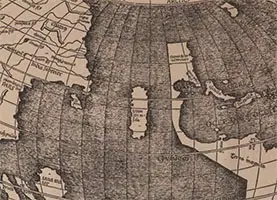 Cosmography is the discipline that is responsible for describing the world from an astronomical point of view. Astronomy , meanwhile, is the science focused on the stars (celestial bodies).
Cosmography is the discipline that is responsible for describing the world from an astronomical point of view. Astronomy , meanwhile, is the science focused on the stars (celestial bodies).
Cosmography is a term that derives from the late Latin cosmographĭa , in turn from the Greek kosmographía . The first record of the use of this concept is found in a work by Claudius Ptolemy , in the 2nd century .
Cosmography, appealing to resources from astronomy and geography , captures different characteristics of the universe through maps . Therefore, it produces graphic representations of the Earth and the celestial vault .
Later, cosmography began to be linked to the tools and resources obtained through astronomy and mathematics to facilitate navigation , especially transatlantic travel. In this way, cosmography was key to promoting trade and exploration.
Throughout the 16th century, for example, the Spanish used cosmography in this way. More specifically, it was used in the Casa de la Contratación de Indias , an institution that originated in 1503 and belonged to the Crown of Castile. The objective of this House was the promotion of navigation between Spain and its overseas colonies.
Previously, since the last portion of the Middle Ages, knowledge related to cosmography had been especially valued by southwestern Europeans. In particular, they were of interest to the Christian kingdoms of the peninsula, which wanted to resolve the monopoly that Italian merchants had in dealings with the East. For this purpose, they tried sailing through the waters of the Atlantic Ocean until they reached the Flemish ports without passing through the Ottoman lands.
The expert whose function was to prepare plans, maps and navigation charts was known as a cosmographer . The senior cosmographer of the Viceroyalty of Peru , for example, had great scientific responsibility in that region: he even taught classes and developed an astronomical yearbook.
 This position was created in 1618 and lasted until after the declaration of Independence, more specifically until 1873. From its first stage until its suppression, the responsibilities of the senior cosmographer increased, even having a position at the University of San José. Marcos, at the head of the Prima Chair. Since the 1680s, a yearbook of astronomical information was added to the preparation of maps and plans, such as The Knowledge of Times , which dates from 1708.
This position was created in 1618 and lasted until after the declaration of Independence, more specifically until 1873. From its first stage until its suppression, the responsibilities of the senior cosmographer increased, even having a position at the University of San José. Marcos, at the head of the Prima Chair. Since the 1680s, a yearbook of astronomical information was added to the preparation of maps and plans, such as The Knowledge of Times , which dates from 1708.
Both the position of senior cosmographer and the yearbook continued in force after Independence, although the latter received different names in its last decades: from repertoire or lunarium to political, ecclesiastical and military guide . In the aforementioned Casa de Contratación de Indias, the position equivalent to that of cosmographer was called Piloto mayor , and its first representative was Américo Vespucio . In fact, already in the first half of the 16th century, the greatest cosmographer and master of making charts was created to complement his work.
The first to occupy this position dedicated to cosmography in the Viceroyalty of Peru was Lucas de Quirós . Since then, thirteen other cosmographers followed over the course of just over a century and a half.
It should be noted that the notion of cosmography is also used to name ancient works and documents that reflected descriptions of the world. In the 7th century, the “Cosmography of Ravenna” was published, compiled anonymously, which includes documentation from previous centuries. In 1507 , meanwhile, “Introduction to Cosmography” ( “Cosmographiae Introductio” ) was published as a complement to Martin Waldseemüller 's map and globe.
